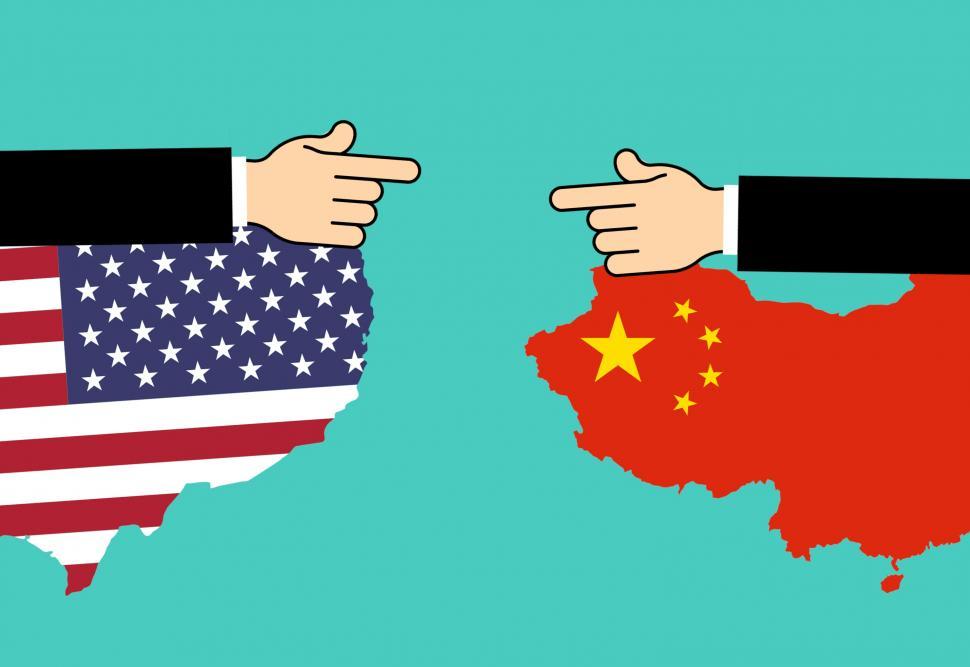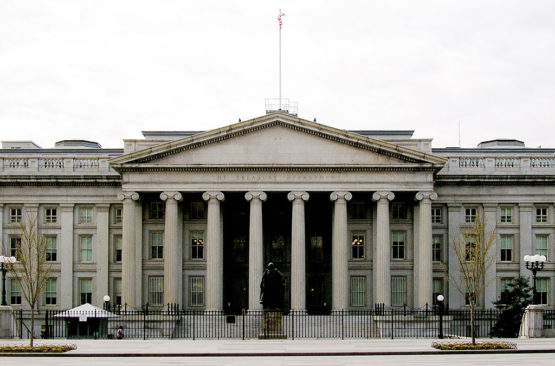Treasury Yield Curve Goes Inverted: Interest Rate Forecast And Recession
 This article was written by the I Know First Research Team.
This article was written by the I Know First Research Team.According to Robert F. Kennedy, the 64th Attorney General of the United States of America, there is an ancient Chinese curse that goes like this: “May he live in interesting times!” By this standard, many of us definitely have a curse to deal with, with newspaper headlines serving as evidence of how interesting these times indeed are virtually every day. And one of the major stories throwing shade on today’s world is the tension between the US and China, a trade war waged between the hegemon in a relative decline against its most potent rival. What does that have to do with interest rate forecast, you may be wondering? Patience, my friends, we are getting there.

Now, while the trade war in itself is too wide a subject to be covered in one article, many commentators have already noted that the United States entered the fray in a very strong position. Record-low unemployment, ever-growing GDP, President Trump’s tax cuts beefing up the business community… That just leaves no chance for China, right? Even the Commander-In-Chief himself once boasted that trade wars are very easy to win for the US.
But what if the US was instead reeling from a recession? What if it had to split its efforts between a struggle with its best frenemy and maintaining its own economic wellbeing? What if the unemployment were to go up, what if the state coffers were to start running short as companies would make less money and thus dish out less in taxes? Would a trade war be as easy to win in this scenario?
History knows no what-ifs, you might respond, and you will be absolutely correct. The problem, however, is that all these questions could become too urgent too soon, since there is one key indicator that has been used to predict an upcoming recession – and it has just started tingling.
Groundhog Rate: Treasury Interest Rate And Recession
Like many other governments, the US government issues debt in order to fund its various projects and activities. The debt comes in the form of securities – namely, Treasury bills, Treasury notes and Treasury bonds – with maturities ranging from a few weeks to 30 years. T-bills feature the shortest maturities of up to 1 year, T-notes cover the middle ground with maturity up to 10 years, and T-bonds are issued with 20- and 30-year maturities.

These securities are traditionally seen as some of the most risk-free investments you can do, as they are backed and paid off by the US government, which means the probability of a default is pretty low. Also, the demand for T-bonds and T-notes can be seen as a reasonable indicator for investors’ confidence in the US economy for the medium and the long run.
Naturally, the securities come with different yields, which, normally, are the lowest for T-bills and the highest for T-bonds. Or, to be more precise, the standard practice for T-bills is to offer no coupon payments per se, but rather sell them at a discount and then repay at the face value, which is where the returns come from. T-notes and T-bonds do include coupon payments and can also be sold at a discount, which would drive their yield up, or, potentially, at a premium, which drives their yield down.
Now, here is the scary part: roughly since May 2019, the yield for the 3-month bills has stayed above the 10-year rates, as anticipated in the recent I Know First interest rate forecast updates. In financial terms, this is known as the inverted yield curve, where longer-maturity securities offer less of a reward.

Why exactly is that scary, you might ask? The problem is, the difference between the rates for the 10-year and 3-month securities issued by the US government has a reputation of being a solid predictor for a recession that is about to strike. The correlation is obvious if you look at the historical graph that tracks this difference, with the last 7 recessions marked by the red areas.

Looking at the plunge that the graph has been taking lately, with the indicator we are tracking already below zero, there is certain ground to talk about the prospect of a recession in the not-so-distant future. However, the inverted curve is also known to have sent false signals before, as it happened in 1966 – or, to be more precise, a recession followed in only 3 years. So are there any more reasons why the US economy may be heading into a recession? Let us take a look.
Trade Wars And The Trade Of Soothsaying
If Donald Trump follows through on the threat to impose 25% tariffs on an extra $300 billion of Chinese goods and Beijing retaliates, the whole world would slump into a recession as early as in 9 months. That’s according to Morgan Stanley as cited by Bloomberg, which says that many top banks are quite wary of the impact that a trade war escalation could have on the global economic health.

These are fair concerns, but they are much more rooted in politics rather than economic indicators. On the economic front, however, the US is still standing strong. The economic growth period would hit record length if it persists until July, and while the job market has been slowing down recently, overall, the unemployment levels are still very low, and we are talking about some of the lowest unemployment on record in the last five decades.
Furthermore, the problem with the indicators like the one that we brought up in the previous section is that, first, an argument can be made that the quantitative easing and other bank policies make the reverse yield curve less of an accurate predictor. On top of that, the inverted yield curve does not predict the scope or length of a recession period, or even when exactly it would strike. Finally, indicators like this also have the capacity to become a self-fulfilling prophesy: as businesses pick up the signal, they can slow down their hiring or get more conservative with their economic activity, thus building up the momentum of the actual recession that would not have been there unless they started trying to offset it.
Now, there is a global economic slowdown to be aware of, and it could, of course, affect the US economy as well. This process could be exacerbated if the trade war continues and escalates, of course, as all eyes are on Washington and Beijing. Would weakness abroad be enough to send the US on a downward spiral from a position as strong as we just discussed? A certain slowdown could be reasonably expected, but a persistent contraction is a whole other matter.
Another key factor is the upcoming Presidential elections in 2020. Just recently, President Trump warned that a stock market crash could be expected should anyone but him take over the Oval Office.
The stock market has indeed been up in the Trump era, and the businesses were invigorated by his tax reforms. However, the stock market is not that reliable as a gauge for the nation’s economic health in itself, and the outcome of the elections is too difficult to predict at this point. It will be important to keep an eye on the line-up of the leaders on both sides of the political aisle, especially in terms of their views on business, to measure how the investors would respond to their potential victories, but we are not at a stage where the stage is set for the showdown.
Too Eary To Brace For Storm
While the interest rate forecast of recession is an important bell ringing for those who like to keep up the pace with the world, currently, the main factors that will define the future health of the US economy (and the global economy, for that matter) seem to lie in the political sphere, not in the world of figures and numbers. Beijing has taken on a defiant stance, reportedly reversing on most of its earlier commitments made in the negotiating process, and the way President Xi is entering the Korean crisis with his first official visit to Pyongyang seems to be another sign of China’s willingness to fight back by all means possible. It remains to be seen, however, whether those means are enough to make the American giant bend the knee. Both sides still have major trump cards to play (for China, it’s almost exclusive control over rare earth minerals, for Washington, it is the threat of the extra tariffs and America’s weight on the global stage), and from here and on, things could go either way, it seems.
Furthermore, while the US election cycle is also set to have an impact, it is too early to try and pick the winners and losers there as we are only at the beginning of the campaigning. The mid-terms saw the GOP secure a majority in the Senate, as the House went to the Democrats, which threw some cold waters on the expectations of a Blue Wave that would fully turn the Congress against the President. It remains to be seen whether the never-ending stream of controversies around the Trump presidency would be enough to galvanize enough anti-Donald sentiment to bring someone else into the White House… And whether that would have too much impact on the stocks as well.
Thus, for now, it seems, the future is uncertain. But in purely economic terms, the US is standing strong and can be expected to maintain this strength unless the changing tides of international politics stir up a trade war tsunami.
Interest Rate Forecast: AI Optimizing Your Strategy
While the future may be uncertain, what we can say with certainty is that Treasury notes are still a worthy investment for those seeking to add a reliable (albeit, arguably, not as well-paying as the riskier financial instruments) asset on their portfolio to hedge against the times of uncertainty. If you are interested in acquiring such assets, check out the Interest rate forecast package provided by the I Know First, which includes AI-driven predictions for over 40 interest-paying assets for a range of time horizons covering the short-, medium- and long-term trading.
The I Know First algorithm makes use of deep learning and chaos theory to model and predict the dynamics for a huge variety of financial instruments, including stocks, ETFs and currency pairs, delivering predictions as a heatmap with two numeric indicators, signal and predictability. Signal shows how well the asset is expected to perform against the rest of the assets on the forecast, while predictability demonstrates how efficient the algorithm was in its earlier predictions for this specific asset.
In the most recent test, the company has shown that its algorithm is capable of consistently beating the benchmark in the interest rate forecast universe across all time horizons, which would help investors optimize their trading strategies. And, due to its capability to predict the moment when the Treasury rate curve goes inverted, as it did this time, the I Know First AI-driven interest rate forecast algorithm can even warn you of an upcoming recession – or, at least, give you a hint that it is time to be more careful.












